The profits they make without risking anything are enormous
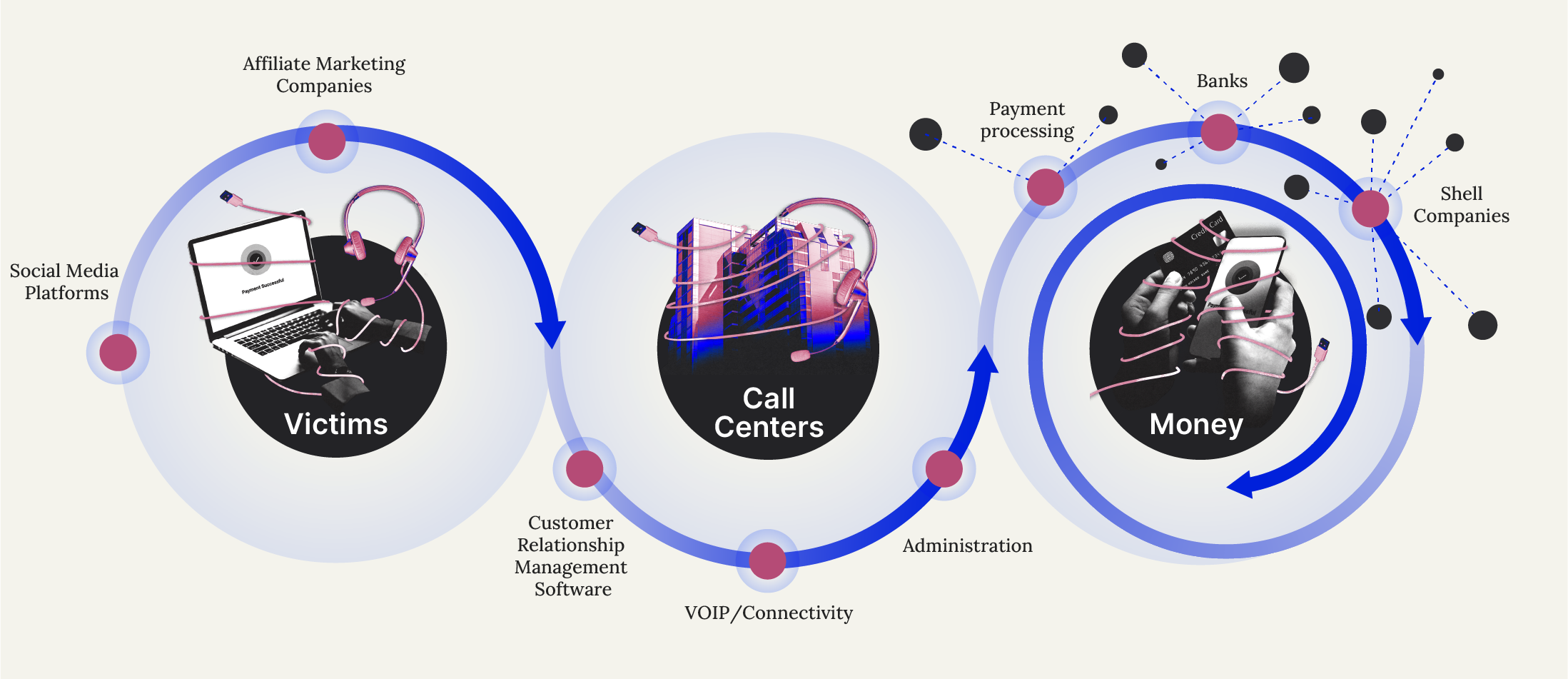
This is a difficult article to excerpt, mainly because it follows the story of one woman and, in doing so, opens up a vast network of professionally-run scam businesses. It’s well worth a read to understand what’s going on in the world, and how much of a whole economy exists swindling people out of money.
Much of this is based on social engineering, as banks and other financial institutions have put in place technical counter-measures. But the landscape is always shifting, and it’s lucrative business when it’s possible to ‘earn’ $20,000/month for working in a well-lit, efficiently-run office.
For crime groups looking to turn a profit, operating a call center can be more lucrative than trafficking drugs, since the margins are higher and the risks of being caught much lower, according to an investigator from Spain’s Mossos d’Esquadra, the Catalonian police, who specializes in investment fraud networks.
[…]
Divided up into different language “desks,” the call center agents use fake names that match the country they are tasked with calling — in the Georgian call center, agents calling Spain had names like “Esteban Fernandez,” while the Russian desk was led by “Kseniya Koen” and the English desk employed “Mary Roberts.”
[…]
“The profits they make without risking anything are enormous,” said the investigator, who was not authorized to speak on the record about his work.
[…]
“Pure phishing frauds, where you can steal a person’s credentials … have been reduced by technical measures,” said Sakari Tuominen, Detective Superintendent of the country’s National Cyber-enabled Crimes Unit. “But then there’s this crime of fraud through social engineering, where a person first builds a trusting relationship … and of course, no technical tools or inhibitions help [in that case].”
Spanish lawyer Mauro Jordan de la Peña said that in his own country, there is a lack of urgency among the police and judiciary to pursue the cases of online investment scam victims, because it is not an issue that triggers as much social alarm as other crimes.
“In Spanish society there’s a sense that, hey, if you are scammed because you wanted to earn a lot of money, then that’s on you,” Jordan said in an interview with OCCRP.
Source: OCCRP
Image: James O’Brien/OCCRP
Three character traits will cause particular problems: caring too much, having values and having standards.
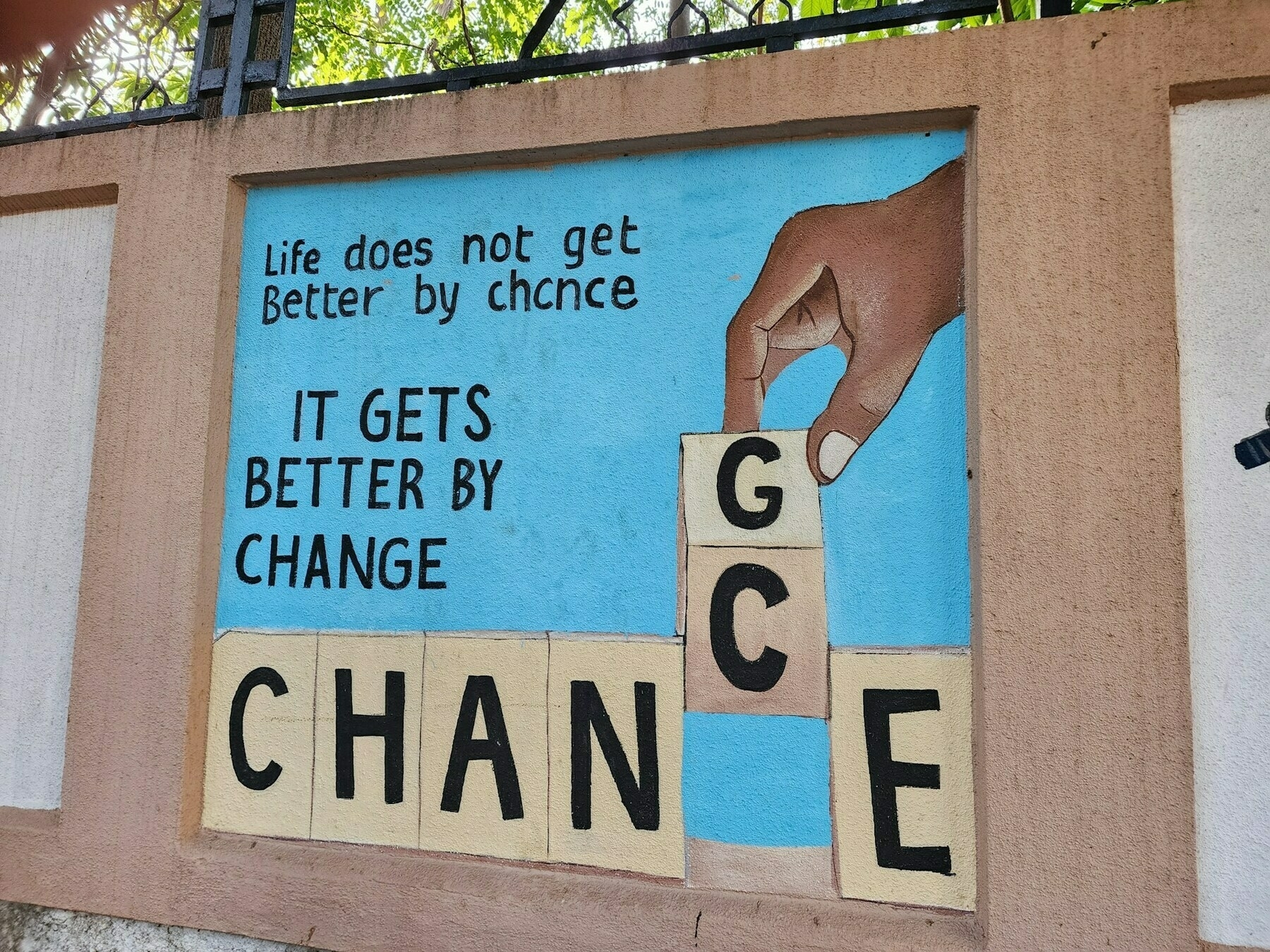
This post by Stephen Kell, an academic at King’s College London’s Department of Informatics, was on the front page of Hacker News recently. It resonated with me, even though I’m not in the same position as him employment-wise. We all have a finite time on this earth, so it’s worth prioritising getting on and doing stuff that you deem important, without bureaucracy and other annoyances (like ‘business development’!) getting in the way.
It’s time to admit that I’m in a mess… It’s a little over ten years since I boldly presented one of my research goals at that 2014 conference. The reception was positive and gratifying. I still get occasional fan mail about the talk. So where’s the progress on those big ideas? There’s certainly some, which I could detail—now isn’t the time. But frankly, there’s not enough. In the past year I turned 40… in fact I’m about to turn 41 as I write this. It’s time to admit I’ve landed a long way from the place where that bright-eyed 30-year-old would have hoped his future self to end up. […]
If not there, then where am I? In short, I’m trapped in a mediocre, mismanaged version of academia that is turning me into a mediocre and (self-)mismanaged individual. The problem is far from one-way traffic: if I were a more brilliant or at least better self-managing individual, I could no doubt have done better. But for now, it’s the mess I’m in. I need to get out of it, somehow.
Although the academic life has felt like my vocation, my current experience of it is one I find suffocating. If you care about things that matter—truth, quality, learning, reason, knowledge, people, doing useful things with our short time on this planet—you are a poor fit for what most of our so-called universities have become in the UK. Three character traits will cause particular problems: caring too much, having values and having standards.
Looking around, what I seem to observe is that whereas others can hack it, it’s an atmosphere I find I am very poorly adapted to breathing. In short, far too much of my time is spent on regrettably meaningless tasks, and the incentives mostly point away from quality. I am trapped in only the bad quadrants of the Eisenhower matrix. To the extent that my mind is “in the institution”, it makes me feel pretty horrible: under-appreciated, over-measured, constantly bullshitted-to, serially misunderstood, encouraged to be a bureaucrat “system-gamer” and discouraged from both actually doing what I’m good at, and actually doing good. There is an enormous and exhausting cognitive dissonance generated by not only the stereotypical bureacracy but also the new, non-stereotypical corporate noise, the institutionally broken attitudes to teaching and the increasingly timewasterly tendencies of [organisations claiming to be] research funders.
It’s not all bad! There are still moments when it feels like my teaching is meaningful and my research time is going on things that matter. Those moments are just too few to sustain me, given the oter stuff. […]
If I’m not just to muddle on like this until I die or at least retire (it’s scarily little time until I can claim my pension!), there’s an imperative either to get out of this suffocating environment or at least to open up a vent… perhaps one large enough to crawl out of later. However, I’m not ready to Just Quit just yet. Being a citizen of the academic world is useful; I don’t have to go for a metaphorical knighthood. My new plan is to focusing more on basic sufficiency. I want to use my citizenship to do good. There is still some will in the machine to do good, even though the the default pathways increasingly strangle such impulses; walking out would squander this meagre but still valuable capital.
Source: Rambles around computer science
Image: ShareYaarNow
What do you *like* to do?

You should already subscribe to Kai Brach’s Dense Discovery newsletter but, if you haven’t yet had the pleasure, I’d like to introduce it by way of his opening to the latest issue.
I find the question “what do you do?” so difficult to answer. I find it difficult enough even explaining what WAO does, to be honest, given how much of a range of stuff we do for clients. So the suggest to reframe the question is a welcome one, and helps shifts our collective conversations away from hierarchical, company-centric ways of being.
The dinner party question we all dread and ask in equal measure: ‘What do you do?’ It’s a peculiar cultural shorthand that attempts to compress our entire existence into a job title and industry. The way we’ve elevated professional identity to the centrepiece of selfhood comes at a considerable cost, narrowing our understanding of value and connection to something that can be neatly added to LinkedIn.
Simone Stolzoff beautifully captures this over-identification with work in his recent TED talk. You might remember his book The Good Enough Job (featured in DD214), which examines this theme at length. In this condensed pitch for a less work-centric life, he reminds us that “we are all more than just workers. We’re parents and friends and citizens and artists and travellers and neighbours. Much like an investor benefits from diversifying the sources of stocks in their portfolio, we, too, benefit from diversifying the sources of meaning and identity in our lives.”
Stolzoff offers three practical steps to help us ‘diversify’ our identities: creating time sanctuaries where work is forbidden, filling those spaces with activities that reinforce alternative identities, and joining communities that couldn’t care less about our professional achievements. It’s blindingly obvious advice, though it feels almost radical in our achievement-obsessed culture.
“If we want to develop more well-rounded versions of ourselves, if we want to build robust relationships and live in robust communities and have a robust society at large, we all must invest in aspects of our lives beyond work. We shouldn’t just work less because it makes us better workers. We should work less because it makes us better people.”
“This is about teaching our kids that their self-worth is not determined by their job title. This is about reinforcing the fact that not all noble work neatly translates to a line on a resume. This is about setting the example that we all have a responsibility to contribute to the world in a way beyond contributing to one organisation’s bottom line.”
And here’s a bit of dinner party advice that might just salvage our collective sanity: rather than asking ‘What do you do?’, Stolzoff suggests adding two small words: ‘What do you like to do?’
“Maybe you like to cook. Maybe you like to write. Maybe you do some of those things for work. Or maybe you don’t. ‘What do you like to do’ is a question that allows each of us to define ourselves on our own terms.”
In a world obsessed with productivity metrics and career trajectories, perhaps this tiny adjustment to our social script might help us recognise each other not just as economic units, but as the complex, multifaceted beings we truly are.
Source: Dense Discovery #328
Image: Antenna
It’s not just making packed lunches

At MozFest 2019, I revealed as part of a group discussion that I don’t use Meta’s products — including WhatsApp. A participant, who knew I have sporty kids, asked how I managed to organise their activities. “My wife uses Facebook and WhatsApp,” I said. “Oh, you outsource the labour?” was their withering reply.
Six years later, and I still don’t use WhatsApp and Hannah (my wife) still sorts all of that stuff out. Any time we’re having a disagreement, she does tend to bring this up as an additional mental burden. So I was interested in this article by Chloë Hamilton in The Guardian where she and her partner “swapped” mental loads for a week.
I recommend reading the whole thing. It probably won’t be what you expect, and it both provided me with some insights and confirmed some things I’d suspected all along. I’d direct you in particular to the bit (not quoted below) about when their kids head off to be looked after by their grandparents…
It starts with a discussion in the car, prompted by the washing up. It wasn’t done that morning. The laundry needs hanging up, too, and someone has forgotten to make the packed lunches. We need to pay the dog walker, fix the broken bath panel, work out why our toddler has started waking in the night and book our youngest in for a haircut. Then there’s a half-planned playdate to confirm, meals to plan and all those family WhatsApp group messages that need a response.
Historically, women in heterosexual relationships have carried the heft of the mental load, also known as cognitive household labour. This is the behind-the-scenes work, often intangible, that goes into running a household. It’s not just the jobs: it’s thinking about those jobs. The true extent of this work, invisible and embedded as it is, can be hard to define; an iceberg of tasks concealed beneath waves of tradition, expectation and stereotypes. It’s not just the doing, it’s the remembering, the realising, the anticipating, the assigning. It’s not just making packed lunches, it’s getting food in, making sure it’s nutritious, checking the lunchboxes are washed and ready. It’s knowing the toddler has gone off bananas and the baby can’t eat chunks of apple yet. This work is unpaid, unseen and, often, unappreciated.
[…]
We conclude, as we pull into the childminder’s, that if long-term change is the objective, talking about it with your partner isn’t just recommended, it is essential – and, actually, doesn’t at all nullify the purpose of the chat. Opening up a dialogue has allowed us to have a respectful, thoughtful and continuing conversation about how we are feeling and faring. We have made the invisible visible.
Source: The Guardian
Image: Helena Lopes
Exploring the many ways in which people interact with place
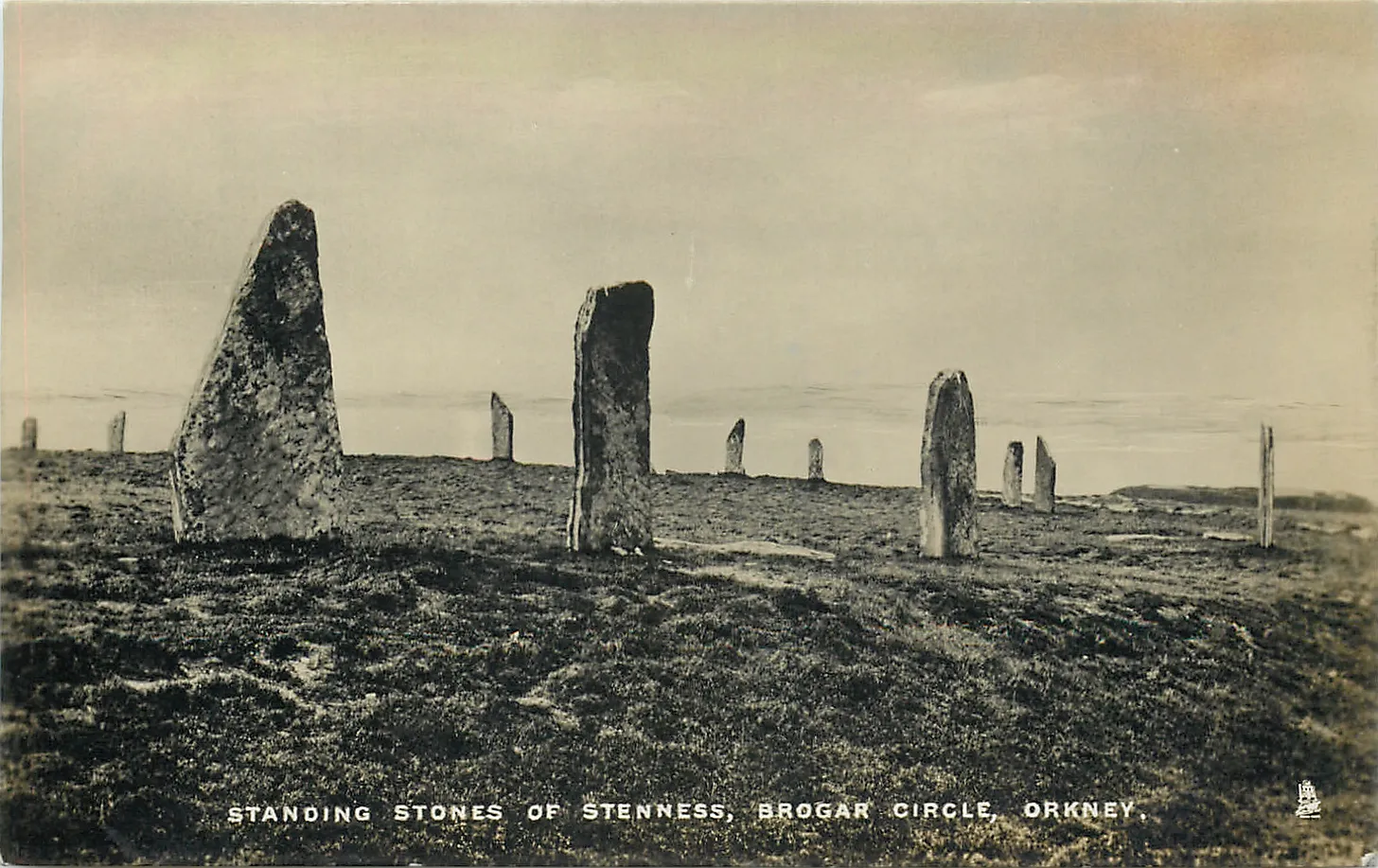
You’re not going to get many recommendations from me to sign up to a Substack-powered newsletter (why?) but I’m going to give you one today. I’m delighted to say that Northern Earth, a magazine I initially subscribed to on the recommendation of author Warren Ellis, is continuing under a new editor, and they have created a new monthly newsletter called The Hare.
Founded in 1979, Northern Earth is the world’s longest-running journal combining interests in archaeology, folklore, neoantiquarianism, earth mysteries, phenomenology and psychogeography – exploring the many ways in which people interact with place.
Don’t get me wrong, the community around the magazine is a broad church, so there’s some things in the magazine at which I raise an eyebrow. But, on the whole, I like alternative explanations of history and pre-history. As Hercule Poirot, the famous fictional detective once said, “If the little grey cells are not exercised, they grow the rust.”
Here are some links from the first issue of The Hare:
Read John Palmer’s new article at our website: A Saxon alignment and pagan cult site in Twente, the Netherlands
11,000-year-old Indigenous village uncovered near Sturgeon Lake, Canada [University of Saskatchewan]
[Podcast] Broken Veil – ‘A psychogeographic journey into the strangeness close at hand’
Image: from the inaugural issue of The Hare
Not an aesthetic of seduction, but of brutal carelessness and blatant ignorance

I didn’t really want to share anything about US politics this week, but I can’t not share this thread from Roland Meyer about the Trump ‘Gaza Riviera’ video that you’ve probably seen by now. Or at least read about. It’s the first time I’ve come across Meyer, who is DIZH Bridge Professor in Digital Cultures and Arts at the University of Zurich and the Zurich University of the Arts (ZHdK).
He says that sharing the video “without trying to understand how it shows our new normal” is problematic, but ignoring it isn’t an option either. I’m sharing his analysis of mainly because ‘platform realism’ is a useful term to avoid just vaguely gesturing to something as ‘AI generated’. The point is that creating this kind of aesthetic is easy and cheap in a world of consumer-grade AI tools which require no particular talent to use.
No-one thinks that this is real, the point is rather to provoke, distract, and demonstrate a brazen disregard for international law. It’s a fabrication of a different reality, something that is absolutely part of the fascist playbook. It started with the ‘Gulf of Mexico’ naming dispute, and continues from there. After all, when you’re trying to refute bullshit, you’re not doing anything else.
There is nothing crazy about this. This horrific video epitomizes the logic of current meme-fascism: it’s a colonization of the imagination that precedes and aestheticizes real neo-imperialist violence, dressed up in the glossy looks of stock imagery, influencer content and online scamming
1/The vision, if you want to call it that, presented in this video is cheap, superficial, inconsistent and hardly capable of convincing, seducing or deceiving anyone. But that’s exactly the point: Trump doesn’t need to convince anyone, he can use his raw power. The video shows how little he cares
2/Unlike 20th century propaganda, #platformrealism is not an aesthetic of seduction, but of brutal carelessness and blatant ignorance. The power of a video like this lies in the sloppiness of its means - anyone could produce it, without expertise, without investment, without even watching it
3/Pointing out AI-induced glitches and hallucinations like the bearded dancers therefore seems to me to be beside the point. Such traditional critique of representation is helpless when those in power are no longer concerned with the details of representation, but only with ›flooding the zone
4/
Source: Bluesky
Image: BBC Verify
It always seemed ripe for mapping and distilling the patterns together more interactively
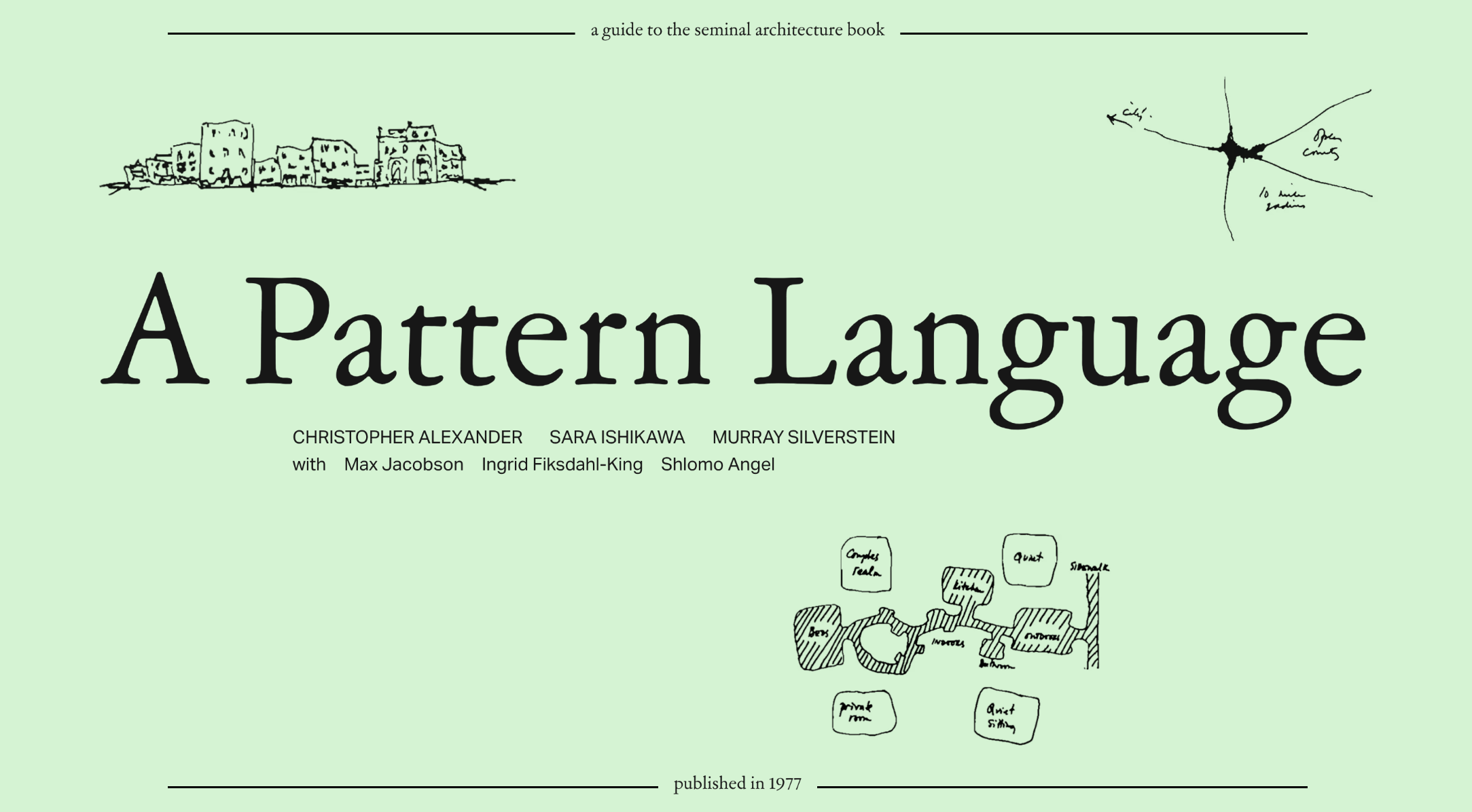
I discovered this via the Are.na newsletter. It’s a kind of social bookmarking and discovery service that strongly influenced some of the early iterations of MoodleNet (RIP).
Anyway, A Pattern Language has been referenced in multiple places I’ve paid attention to over the years, but the book is usually expensive. That’s why I’m pleased that there’s now this interactive version, which links the ideas it contains to one another, as a hypertext.
A Pattern Language is the second in a series of books which describe an entirely new attitude to architecture and planning. The books are intended to provide a complete working alternative to our present ideas about architecture, building, and planning—an alternative which will, we hope, gradually replace current ideas and practices.
My friends and I have long been fans of this book, and attempt to use its patterns in our own homes and spaces. The book is 1,200 pages long, with countless intertextual connections. It always seemed ripe for mapping and distilling the patterns together more interactively. All text, except this section, is excerpted from the book.
Source: A Pattern Language
Cracking cheese, Gromit

Sometimes, the internet reminds you how weird and wonderful humans are. On this occasion, it was the above image which people replied to with their best slogans. I’m including some examples from a dedicated Reddit thread, but I think first prize has to go to Giles Turnbull who captioned the image “Cracking cheese, Gromit.”
Absolutely perfect. Nailed it.
“I have a cunning plan” (Humannylies)
“Don’t piss on me and tell me it’s raining.” (LondonEntUK)
“Nice to see you… to see you, nice” (Naturally_Fragrant)
“…there aren’t no party like an S Club party.” (nasted)
“You’ve been Tangoed” (LeicsBob)
Source: Reddit
Everything happens in a place

Years ago, when I was a teacher, we had an influx of Polish children to our school. After a couple of weeks, one of the senior leaders gave the new pupils a map of the school and asked them to add a smiley face, a neutral face, or an unhappy face depending on how they felt about those spaces. Many of them couldn’t speak English, so it was a really important way of starting to figure out how, where, and why they were feeling included or excluded.
I was reminded of this when reading this post about “maps as conversations”. It’s a way of understanding how different groups understand and move through spaces. It’s a way of having multiple maps of the territory, rather than just the official versions.
I’m having a chat with Tom Watson, one of the authors next week, so I’m looking forward to finding out more. Especially as one of the areas used as an example is Sheffield, where I went to university as an undergraduate.
What started as an idea that “everything happens in a place” has turned into a practical, replicable initiative. Through the power of citizen-led mapping, Sheffield’s communities have already begun to shift how we talk about places, how we deliver services, and how we make decisions together.
We think other areas now have the chance to adapt and benefit from this model. By grounding policy and practice in how people actually live, connect and identify, localities can cultivate greater participation, more cohesive relationships and a richer sense of community ownership.
Source: Data for Action
Image: (from the post}
Once upon a time, personal or honest takes were regarded as awkward and professionally desperate

You can definitely tell how old someone is by the way they use LinkedIn. If someone announces a job move by saying they have “some personal news” they are definitely Gen X. I’m a Xennial so just super-awkward on every social platform; I’m torn between wanting to look/sound “grown up” and just wanting to share all of the things everywhere.
LinkedIn, though, is absolutely crushing it in terms of engagement and revenue. If you think about it, the main feed is very different to how it used to be, and that’s a function of younger generations entering the workforce, as well as more people working from home. It’s difficult to remember to be super-professional when you’re still in your running gear and you’ve just hung up the washing between Zoom calls.
As this article discusses, the interplay between the generations on LinkedIn is really interesting. It’s more likely that older generations are believers in working from an office in a hierarchical structure; it’s more likely that younger generations are opposed to both of those things. I still find it an annoying place to kind-of-have-to hang out. I’d prefer it didn’t exist, or at least prefer that it had a different overall vibe. But, while it is the main professional network, I’m going to share all of the things there.
Last week, Microsoft revealed that the site is seeing record engagement, with comments on the platform up 37% year over year. Moreover, millions of people have now signed up for LinkedIn Premium; the company revealed that it’s earned more than $2 billion in revenue from its AI-laden premium service in the last 12 months. Indeed, LinkedIn more broadly contributes healthily to Microsoft’s bottom line — the division delivered $16 billion in revenue in 2024, more than The New York Times, Zoom, and Docusign put together.
[…]
Younger generations tend to reflexively reject spending time on the same online social media platforms as their parents (here’s looking at you, Facebook). But, unfortunately for the youth, you do tend to turn into your parents as you age, and LinkedIn is no exception. As Gen Z has entered the workforce, they seem to have no problem with the site, with the number of American Gen Z users on LinkedIn estimated to have risen 14% in 2024, per Insider Intelligence. But those younger users post on the site in a very different way.
Once upon a time, personal or honest takes were regarded as awkward and professionally desperate on LinkedIn. But being a so-called “thinkfluencer” in 2025 is increasingly a strategic way to boost your “personal brand” (should you desire to have such a thing). After a number of conversations with small business owners over the last few months, the reality is that posting every single day on LinkedIn, even if it feels uncomfortable at times, is a bona fide way of bringing in leads.
[…]
With more and more people dipping their toes into remote working, definitions of what’s socially acceptable to share at work are also changing. It’s this interplay between generations and workforces (work-from-home vs. work-from-office), and the fact that some make serious money from the platform, that makes LinkedIn — for lack of a better word — weird.
Source: Sherwood
Image: Never Dull Studio
But I blogged about that in detail a while back, shall I send you a link later?

Writing is a form of extended thinking. Or, at least it is for me. Which is why I think that blogging, either here on Thought Shrapnel, on my personal blog, on the WAO blog, or occasionally over at ambiguiti.es, is so useful.
Giles Thomas points out that a blog is the equivalent of showing your contributions to open source software via a GitHub profile. It’s a good analogy: by working openly and sharing your thinking, you create a link for every significant thought or connection you’ve made between ideas. That means, in my case at least, I can search for my name and the topic, and a bunch of things come up.
Although I haven’t included it in the quotation below, the original rationale for Thomas' post is whether it’s worth blogging in the age of AI. It’s an unequivocal YES for me, but then I’m the kind of person who donated my doctoral thesis to the public domain. Nobody “owns” ideas, so by blogging you’re helping contribute to the sum total of human knowledge.
I said that you will be vanishingly unlikely to make a name for yourself with blogging on its own. But that doesn’t mean it’s pointless from a career perspective. You’re building up a portfolio of writing about topics that interest you. Imagine you’re in a job interview and are asked about X. You reply with the details you know, and add “but I blogged about that in detail a while back, shall I send you a link later?” Or if you’re aiming to close a contract with a potential consulting client in a particular area – wouldn’t it be useful to send them a list of links showing your thoughts on aspects of exactly that topic?
Your GitHub profile shows your contributions to open source and lets people know how well you can code. But your blog shows your contributions to knowledge, and shows how well you can think. That’s valuable!
Source: Giles' blog
Image: Markus Winkler
If a waiter has to explain the “concept” behind a menu there is something wrong with the menu

For those unaware, for the past 15 years, Jay Rayner has been the food critic for The Guardian and its sister publication, The Observer. The latter has a ‘food monthly’ supplement which is usually referred to by the acronym OFM.
In Rayner’s last column for OFM he dispenses lots of fantastic advice. Here’s are my favourite parts, some of which can be used as metaphors and are therefore more widely applicable.
Individual foods are not pharmaceuticals; just eat a balanced diet. There is nothing you can eat or drink that will detoxify you; that’s what your liver and kidneys are for. No healthy person needs to wear a glucose spike monitor; it’s a fad indulged by the worried well. As is the cobblers of being interested in “wellness”, because nobody is interested in “illness”. People have morals but food doesn’t, so don’t describe dishes as “dirty”. And stop it with the whole “clean eating” thing. It’s annoying and vacuous.
[…]
Tipping should be abolished. It’s wrong that restaurant staff should be dependent on the mood of the customer for the size of their wage. They should be paid properly. It works in Japan, France and Australia. It can work in the UK. All new restaurants should employ someone over 50 to check whether the print on the menu is big enough to be read, the lighting bright enough for it to be read by and the seats comfortable enough for a lengthy meal. If a waiter has to explain the “concept” behind a menu there is something wrong with the menu.
Source: The Observer
Image: Damien Santos
I call it the feediverse. It's not a joke.
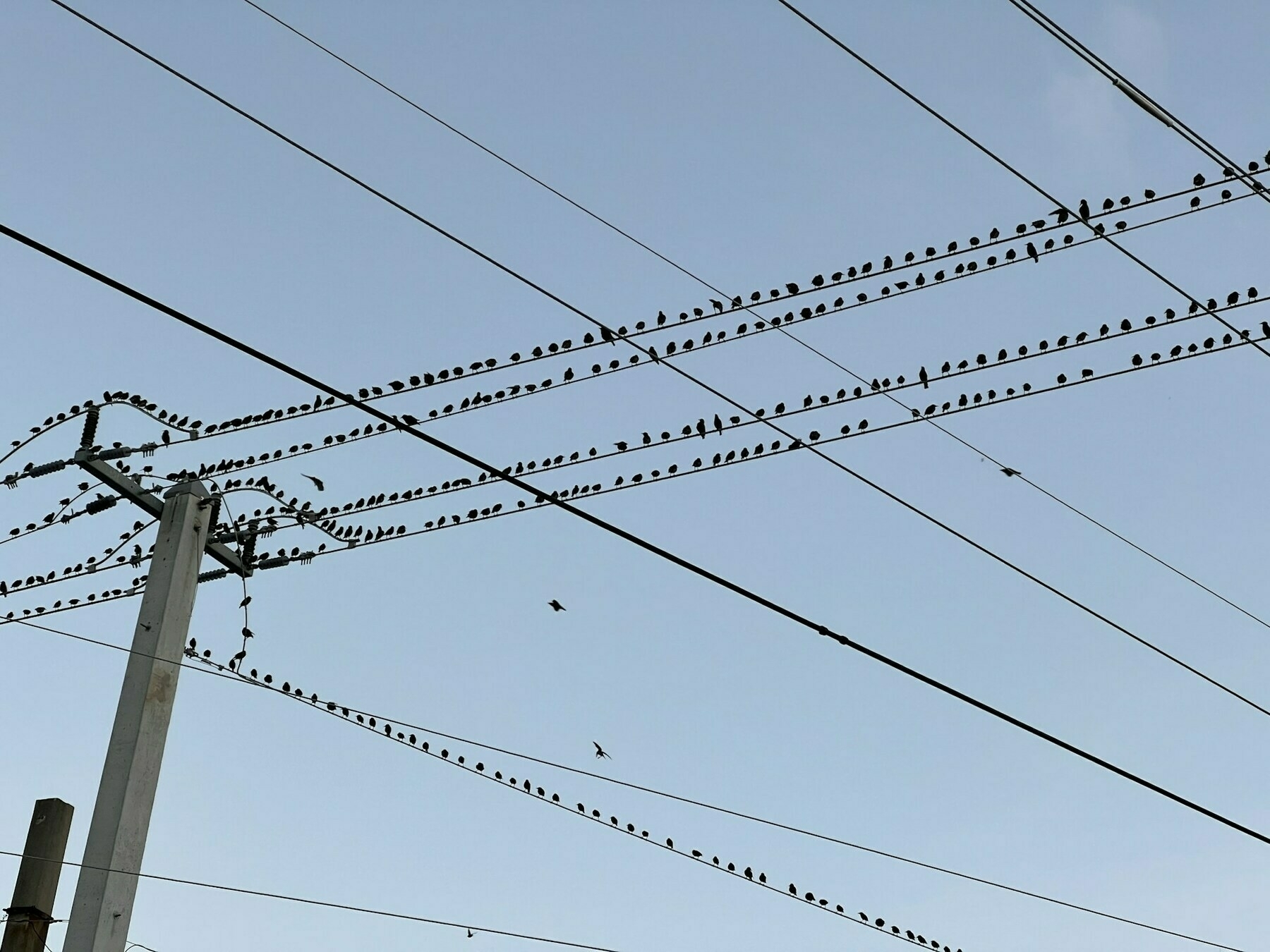
Dave Winer has launched something called WordLand which uses RSS as the federated specification underpinning a federated social network. This is instead of ActivityPub, which underpins the Fediverse (Mastodon, Pixelfed, etc.) or ATProto, which powers Bluesky.
I immediately ran into an error about API calls, with no suggestion how to fix it. I’m also not entirely sure how textcasting is different to just, blogging? This approach seems a bit post hoc, ergo propter hoc. Just as with something like Delta Chat which piggybacks on email for chat functionality, this uses blogs for microblogging 🤔
Thanks to John Johnston for bringing this to my attention, and for pointing me towards PootleWriter which looks simple and great for quickly getting things on the web.
WordLand is designed to be the kind of editor you use in a social app like Bluesky or Mastodon, but with most of the features of textcasting.
WordLand is where we start to boot up a simple social net using only RSS as the protocol connecting users. Rather than wait for ActivityPub and AT Proto to get their acts together. I think we can do it with feeds and start off with immediate interop without the complexity of federation. I call it the feediverse. It’s not a joke, although it may incite a smile and a giggle. And that’s ok.
Source: Scripting News
Image: Juno Jo
The idea stood up to more than casual scrutiny

There is enough going on in the world and in my life at the moment that Thought Shrapnel does not need to deal with. Instead, dear reader, I present to you PJ Holden’s microfiction newsletter, A4. Just like Jay Springett’s Start Select Reset zine.
A4 is a single A4 sheet of paper with seven little nano-fiction stories. The sheet is designed to be printed and folded in such a way that you end up with a lovely little standee with a pulp fiction like cover. (Or you could just read them on screen! but I promise, it’s worth the effort!)
Issue Zero was my test fire to see if the idea stood up to more than casual scrutiny and so far, a surprising number of people have downloaded it (I have the stats!)
Source: PJ Holden’s Blog
Image: from the author’s post
Sometimes life seems really short, and other times it seems impossibly long
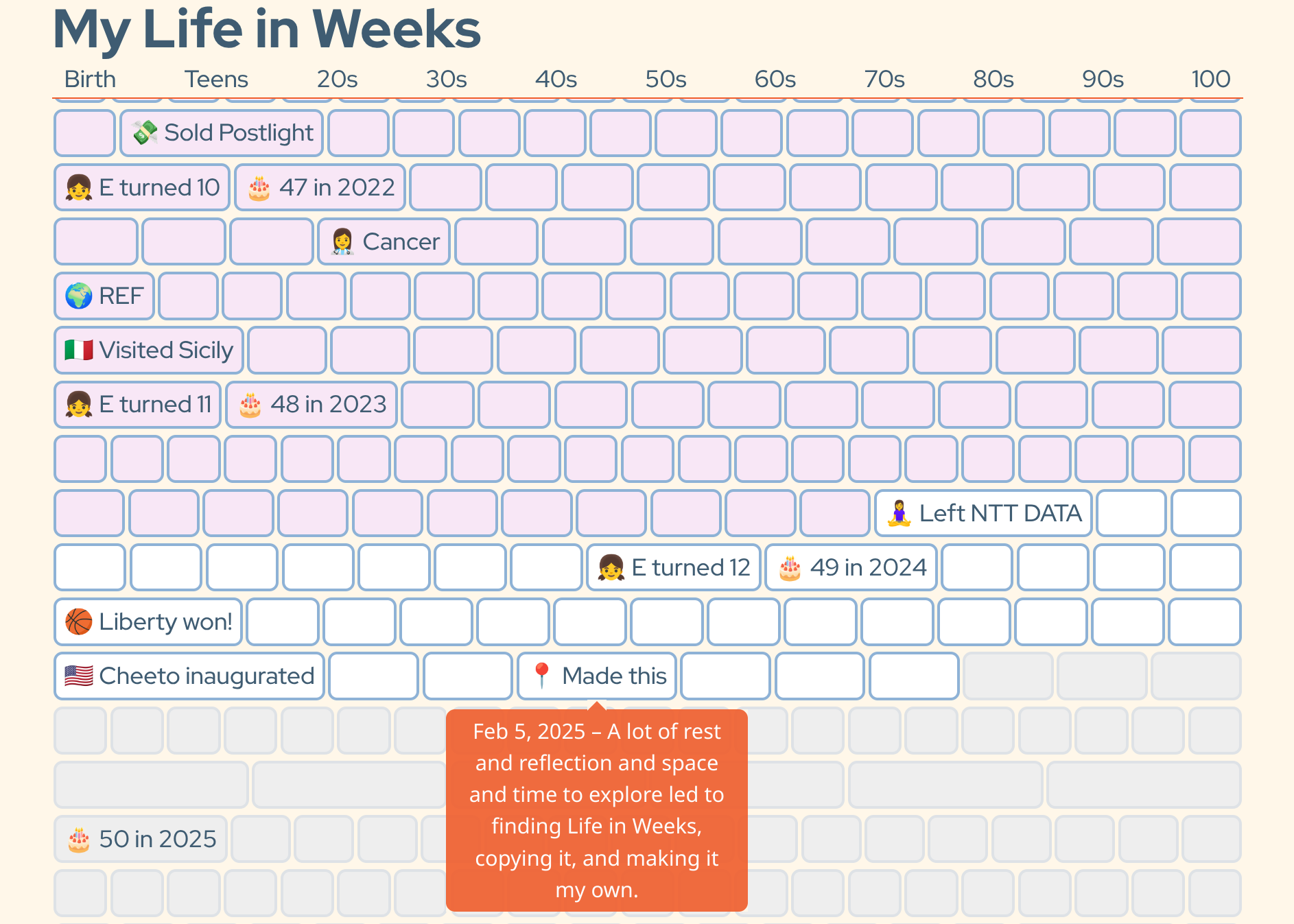
Matt Muir links to My Life in Weeks by Gina Trapani, which she adapted from Buster Benson. He got the idea from Tim Urban. You can create your own version at weeksofyour.life.
I like the idea of representing one’s life like this, for several reasons. First, as Urban’s initial post points out:
Sometimes life seems really short, and other times it seems impossibly long. But this chart helps to emphasize that it’s most certainly finite. Those are your weeks and they’re all you’ve got.
Personally, 2025 has been terrible for me so far. But we’re only a few weeks in! The rest of it could be great, who knows?
The boxes can also be a reminder that life is forgiving. No matter what happens each week, you get a new fresh box to work with the next week. It makes me want to skip the New Year’s Resolutions—they never work anyway—and focus on making New Week’s Resolutions every Sunday night. Each blank box is an opportunity to crush the week—a good thing to remember.
Source: (various)
Image: Screenshot from Gina Trapani’s site
Nostalgia tells you that your personal history wasn’t just scary or tragic; it helped make you who you are

I’ve been listening to an interesting interview over the past couple of days where Rick Rubin, the legendary music producer, interviews Will Smith. One of the things Smith says is that people have a real “thirst” for nostalgia at the moment, wanting to go back to a time when things were a little bit better.
This article by Olga Khazan in The Atlantic looks at some of the research into this topic, noting that that reflecting on past times, even if they were tough, gives them a story, a sense of self, and a sense of solidarity with others. Ultimately, it seems, nostalgia is all about creating a sense of security, which absolutely makes sense.
Nostalgia for terrible things may sound absurd, but many people experience it, for reasons that speak to the way people make meaning of their lives. The central reason for this phenomenon, according to researchers who study nostalgia, is that humans look to our past selves to make sense of our present. Reflecting on the challenging times we’ve endured provides significance and edification to a life that can otherwise seem pointlessly difficult. The past was tough, we think, but we survived it, so we must be tough too.
To be sure, part of the explanation is that people tend to romanticize the past, remembering it more rosily than it actually was. Thanks to something called the “fading affect bias,” negative feelings about an event evaporate much more quickly than positive ones. As a difficult experience recedes in time, we start to miss its happier aspects and gloss over the challenges. And nostalgia is usually prompted by a feeling of dissatisfaction with the present, experts say, making the past seem better by comparison.
[…]
There are few large, robust studies on this topic, but some experimental research has shown that nostalgia provides a feeling of authenticity and a sense of connection between your past and present selves. Because of this, we often get nostalgic for consequential moments in our lives. “People are nostalgic for things that give their lives meaning or help them feel important,” says Andrew Abeyta, a psychology professor at Rutgers University.
[…]
Reminiscing about a difficult experience reminds you that at least you survived, and that your loved ones came to your aid. “The fact that those people did those things for you, or were there for you, reassures you that you have your self-worth,” Batcho said. Research by the psychologist Tim Wildschut and his colleagues found that people who wrote about a nostalgic experience went on to feel higher self-esteem than a control group, and they also felt more secure in their relationships.
Source: The Atlantic
Image: Jon Tyson
All things good should flow into the boulevard

Warren Ellis comments on fractured and fragmented the world is now in terms of keeping up with what other people are thinking and producing. You can’t trust the algorithms any more, and there are precious few people doing the curatorial work across multiple streams — which is why I appreciate people like Jason Kottke, Tina Roth Eisenberg, Stephen Downes, Matt Muir and, of course, Ellis himself.
I was talking to a publisher friend last night about Patreon, on which he spends a lot of time looking at comics creators. I do not – I didn’t find out until last night that I still have an account on there, and I’m still not sure how that’s possible. Anyway. His thing was: he sees lots of work-in-progress and one page updates and stuff there, but how has it not become a primary delivery system for digital comics? Like, for your membership fee, or an extra dollar or whatever, here’s the first issue of my comic for you to read online or download, and the next one will be on this day next month, and so on. Maybe there’s a limited physical print edition that I’ll offer for sale a month later. And there’s no deal for collection, so maybe you’ll never see this again.
(It occurred to me this morning that any writer could do that with ebooks, too, and then whack them out to Amazon two months later.)
My thing was, does anyone really want to fracture common culture and a shared marketplace any more than it already is? And an hour later, I thought, common culture is a delusion of my age. Common platforms, perhaps, but platforms are contingent and temporary. We are all “creators” now.
Is there even a digital comics store and reading app that a majority of people use now?
(There is a supposed quote by Pericles I heard years ago but never sourced: “All things good should flow into the boulevard.”)
This note from my friend, which I summarise here to preserve it for myself, has gotten me thinking about that entire space. It’s less walled-off from the world than Kickstarter-style crowdfunding, perhaps? (I think Kickstarter and Backerkit et al are great: my concern over work crowdfunded in that style doesn’t transmit anything into the general culture. Again, probably a fixed idea from my age and background.) I’m always wondering how much great work I might be missing simply because I can’t find it browsing around real or virtual shelves.
Source: Warren Ellis Ltd
Image: Jonas Stolle
The revolution, it turns out, is boringly iterative
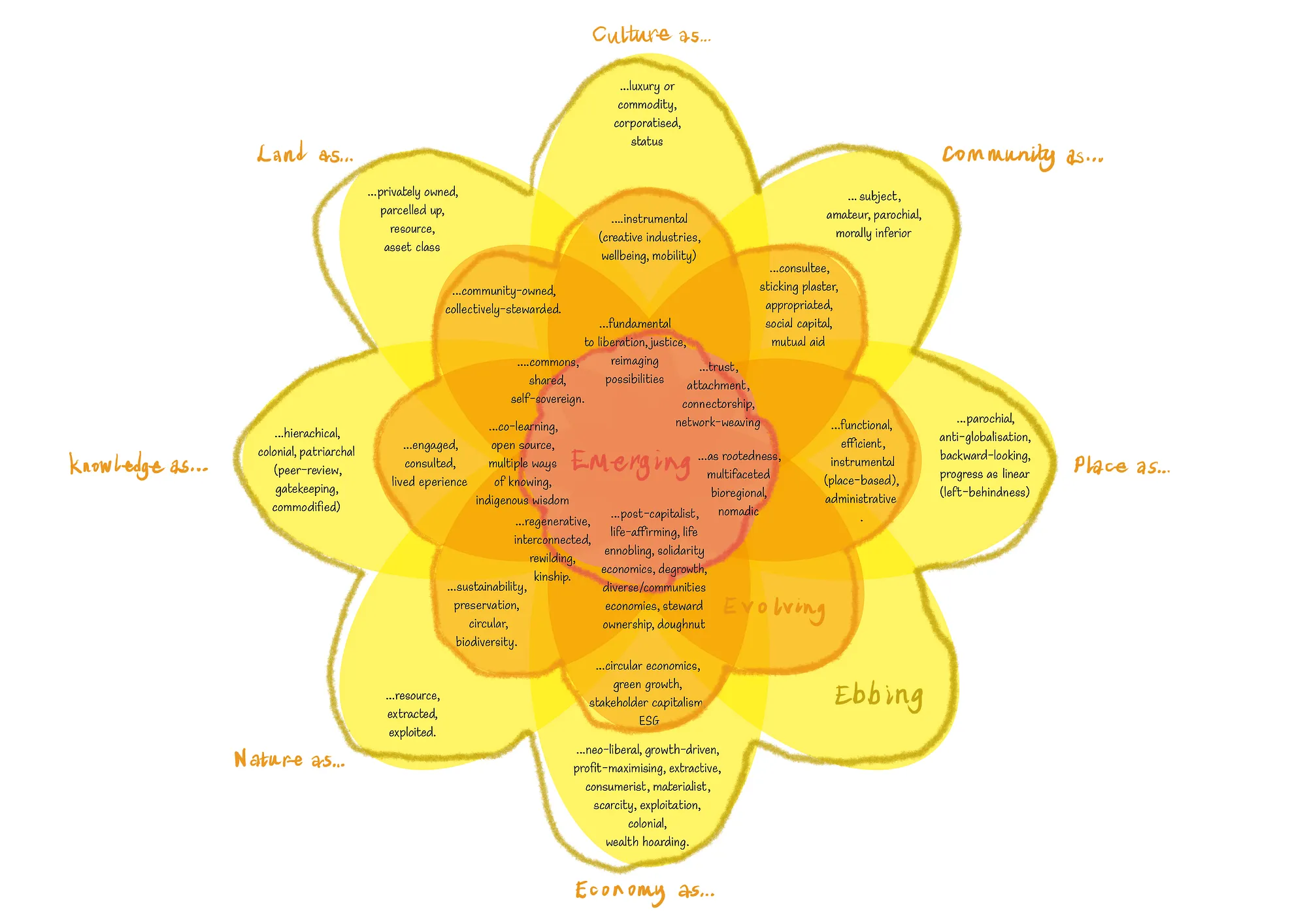
Jessica Prendergrast is part of Onion Collective, which undertook an experimental research project last year funded by the Joseph Roundtree Foundation. In this first of a series of four essays, Prendergrast explores new models for transforming systems beyond capitalism, ultimately coming up with a new three-part Ebbing/Evolving/Emerging model they name Onion Collective’s Petal Model of Regenerative Transition.
I like the emphasis on language and metaphor in shaping our understanding of change, as well as the potential for innovation at the periphery of society. It’s a hopeful piece, which is what we need in such times. I’ve included the image of the model which gives some examples, to aid with understanding.
At Onion Collective, positioned as we are in the ‘niche’, the further we delved into system transformation or replacement, the more conscious we became of how all these models, without fail, position the radical as outliers — trying to break in — rather than centre-ing them as dominant forces of change, reinforcing their radicalism as oddity. Whether unintentionally or a symptom of internalised capitalism, this seemed to reflect how anything which challenges the status quo is targeted as ‘radical’ or ‘extreme’. Rebecca Solnit explores this phenomenon in her extraordinary book, Hope in the Dark. She explains how those who are marginalised, especially when they try to push through to the centre, are often portrayed as dangerous and unsavoury, defamed and even criminalised. This was as true for civil rights activists, suffragettes, and abolitionists, as it is now with climate activists and post growth academics. They are portrayed as rabble on the fringe, somehow both naive (or swampy or woke depending on your era) and dangerous — a kind of system-level dismissal or sniggering at those suggesting an alternative to the mainstream, and one which feels particularly galling when that mainstream is creaking (burning, flooding, dying) under the weight of the damage it has created.
[…]
To reflect where the radical power for change really lies, as a starting point, we wanted to convey emerging and alternative futures practitioners less like oddities or outliers and more like a new beginning at the heart of the model. We wanted a model that better represented the viewpoint and power of all those under the waterline (whether in the global south or left-behind places) and that could begin to change what was ‘thinkable’. In the metaphorical battle for hearts and minds, we wanted to find a way to position the dominant but damaging paradigm as on the edge — a far more logical placement in the sense of the ‘extremeness’ of a position that is destroying itself and the planet. And, we put the alternative future in the centre of the action rather than the outskirts of possibility.
[…]
Intentionally, the three rounds of petals are layered up on top of one another reflecting that the new lives alongside the old even as it envelops it and, as we learned from Gibson-Graham, that all sorts of non-dominant regime activity is always happening alongside the mainstream. The layering and overlap also recognises that most of those building alternative futures are operating in what we have described previously as a liminal space. They tend to be working in multiple arenas all at once, and balancing the contradictions and complexities of such all the time. They may be doing a fair bit of ebbing, evolving and emerging work at once, by virtue of existing in the contradictory reality of late-stage capitalism.
The revolution, it turns out, is boringly iterative.
[…]
An example version here shows a host of areas added. In this case, these are petal sets that felt especially relevant to our practice at Onion Collective. For example, our work is at the nexus of culture, community and climate work; it takes in explorations of land use and ownership; knowledge production and sharing and alternative demonstrations of economics in place and at a systems level.
[…]
Viewed from the centre of this flower, where it’s all fresh and new and emergent, far away from the browning decaying edges of the old regime’s petals, it becomes easier to imagine the end of capitalism. From here, to overplay and mix up the metaphors, the ice above the waterline could melt away. From here, looking at all the activity and dreams and hopes that are coalescing under the surface, it’s not so difficult to conceive that maybe, we’ve just been looking in the wrong place, blinded by the light of capitalism. After all, the history of the world tells us that dominant paradigms dominate only until they don’t anymore. Eventually they give way, either gently or in turbulence, to something else. Change is inevitable, new petals will unfurl and a different kind of flower will come into bloom.
Source: Onion Collective
Image: taken from the article
It's better than strapping clay crocodiles to people’s heads and praying for the best

As I have written about several times over the years, I am a migraineur. They have been with me all my adult life, and I can’t really remember what life was like without them. Preventative medication makes me drowsy, so along with some relieving triptans my only relief is rest.
I’ve sent this article in Nature to my immediate family, who seem to confuse certain migraine phases with neurodiversity. The diagram below, in particular, is extremely valuable to anyone who is a migraineur, or who knows one. It’s easy to focus on the visual disturbances and the cranial pain, but there’s much more to it than that.

And, as I’ve discussed before, post-migraine is an extremely fertile time for me, with it being the perfect time for creative pursuits, including coming up with new or innovative ideas. That being said, I’m not entirely sure that the benefits outweigh the drawbacks, which is why I would absolutely explore new drugs which help prevent them in novel ways.
For ages, the perception of migraine has been one of suffering with little to no relief. In ancient Egypt, physicians strapped clay crocodiles to people’s heads and prayed for the best. And as late as the seventeenth century, surgeons bored holes into people’s skulls — some have suggested — to let the migraine out. The twentieth century brought much more effective treatments, but they did not work for a significant fraction of the roughly one billion people who experience migraine worldwide.
Now there is a new sense of progress running through the field, brought about by developments on several fronts. Medical advances in the past few decades — including the approval of gepants and related treatments — have redefined migraine as “a treatable and manageable condition”, says Diana Krause, a neuropharmacologist at the University of California, Irvine.
[…]
Researchers are trying to discover what triggers a migraine-prone brain to flip into a hyperactive state, causing a full-blown attack, or for that matter, what makes a brain prone to the condition. A new and broader approach to research and treatment is needed, says Arne May, a neurologist at the University Medical Center Hamburg–Eppendorf in Germany. To stop migraine completely and not just headache pain, he says, “we need to create new frameworks to understand how the brain activates the whole system of migraine”.
[…]
Researchers found that changes in the brain’s activity start appearing at what’s known as the premonitory phase, which begins hours to days before an attack (see ‘Migraine is cyclical’). The premonitory phase is characterized by a swathe of symptoms, including nausea, food cravings, faintness, fatigue and yawning. That’s often followed by a days-long migraine attack phase, which comes with overwhelming headache pain and other physical and psychological symptoms. After the attack subsides, the postdrome phase has its own associated set of symptoms that include depression, euphoria and fatigue. An interictal phase marks the time between attacks and can involve symptoms as well.
[…]
The limbic system is a group of interconnected brain structures that process sensory information and regulate emotions.. Studies that scanned the brains of people with migraine every few days for several weeks showed that hypothalamic connectivity to various parts of the brain increases just before a migraine attack begins, then collapses during the headache phase.
May and others think that the hypothalamus loses control over the limbic system about two days before the attack begins, and it results in changes to conscious experiences that might explain symptoms such as light- and sound-sensitivity, or cognitive impairments. At the same time, the breakdown of hypothalamic control puts the body’s homeostatic balance out of kilter, which explains why symptoms such as fatigue, nausea, yawning and food cravings are common when a migraine is building up, says Krause.
Migraine researchers now talk of a hypothetical ‘migraine threshold’ in which environmental or physiological triggers tip brain activity into a dysregulated state.
Source: Nature
Images: taken from the article
The consumption of generative AI as entertainment seems like another order of psychic submission

I quoted with approval from the first part of R.H. Lossin’s essay in e-flux on “the relationship between art, artificial intelligence, and emerging forms of hegemony.” In the second part, she puts forward an even more explicitly marxist critique, suggesting that being human involves both embodiment and emotion — something that AI can only ever imitate.
What I particularly appreciated in this second part was the focus on domination. I could have quoted more below, including one particularly juicy bit about Amazon’s Mechanical Turk, NFTs, and exploitation. You’ll just have to go and read the whole thing.
The liberal impulse to redress historic wrongs by progressively expanding the public sphere is nothing to scoff at. There couldn’t be a better time for marxists to climb down and admit the social value of including someone other than white heterosexuals in public discourse and cultural production. That said, counterhegemonic generative AI is a fantasy even if you define the diversification of therapy as counterhegemonic. In addition to causing disproportionate environmental harm, these elaborate experiments with computer subjectivity are always an exercise in labor exploitation and colonial domination. Materially, they are dependent on the maintenance and expansion of the extractive arrangements established by colonialism and the ongoing concentration of wealth and intellectual resources in the hands of very few men; ideologically they require increasing alienation and the elimination of difference. At best, these experiments offer us a pale reflection of intellectual engagement and collective social life. At worst, they contribute to the destruction of diverse communities and the very conditions for the solidarity required for real resistance.
[…]
The suggestion that a self-replicating taxonomy can produce knowledge and insights generally formulated over the course of a human life seems to defy reason. But this is exactly the claim being made by […] techno-boosterism at large: that a sophisticated enough machine can replicate the most complex human creations. This is, of course, just how machine production has always worked and evolved—each generation witnessing the disappearance of a set of skills and body of knowledge thought to be uniquely human. Art making, writing, and other highly skilled intellectual endeavors are not inherently more human, precious, or worthy of preservation than any skilled manufacture subsumed by the assembly lines of the past century. In the case of generative AI and other recent developments in machine learning, though, we are witnessing both the subsumption of cultural production by machines and the enclosure of vast swathes of subjective experience. Dramatic changes to production have always been accompanied by fundamental changes in the organization of social life beyond the workplace, but this is a qualitatively different phenomenon.
[…]
In the nineteenth century, Karl Marx observed that machinery is not just a means of production but a form of domination. In a mechanized, industrial economy, “labor appears […] as a conscious organ, scattered among the individual living workers at numerous points of the mechanical system […] as itself only a link of the system, whose unity exists not in the living workers, but rather in the living (active) machinery.” This apparent totality of machinery “confronts [the worker’s] individual, insignificant doings as a mighty organism. In machinery, objectified labor confronts living labor […] as the power which rules it.” […] Theodor Adorno and Max Horkheimer described popular entertainment as a relentless repetition of the rhythms of factory production; a way for the workplace to haunt the leisure time of the off-duty worker. The consumption of generative AI as entertainment seems like another order of psychic submission.
Source: e-flux
Image: Rashaad Newsome Studio (taken from the essay)